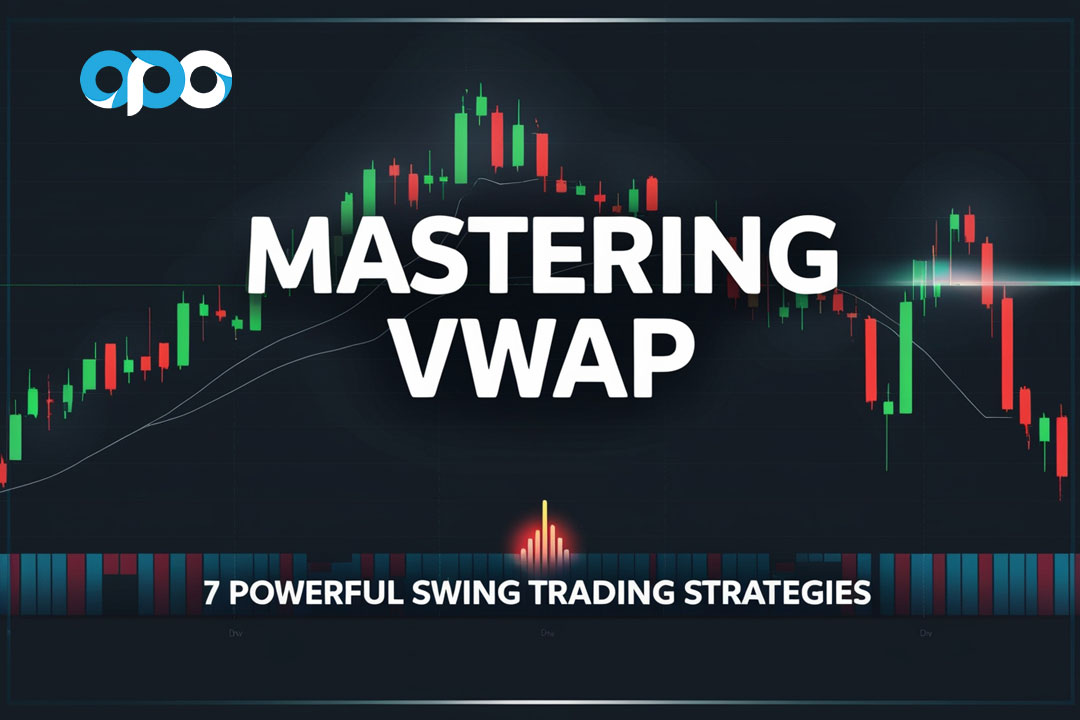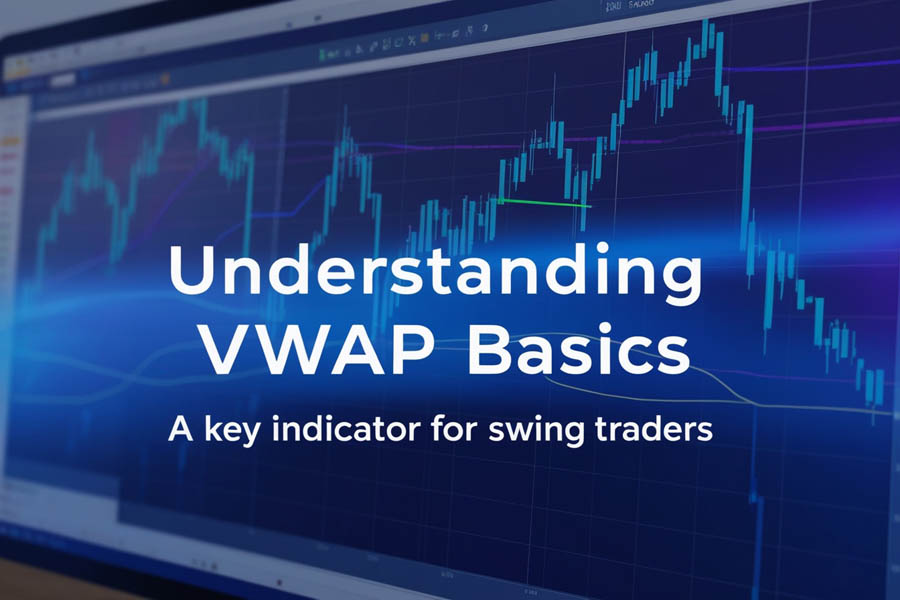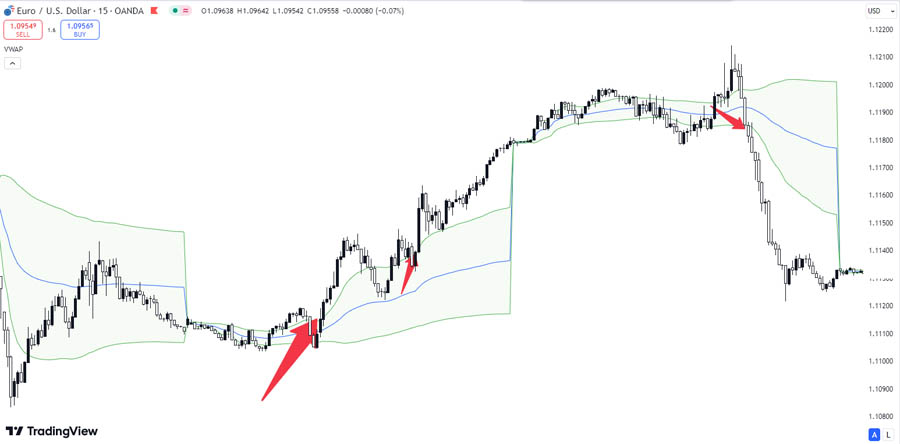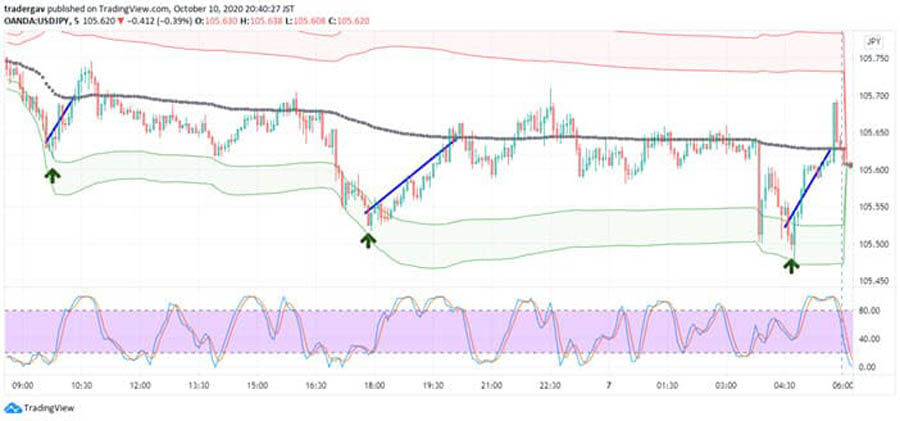A VWAP swing trading strategy is a trading approach that uses the Volume Weighted Average Price (VWAP) to identify buy and sell signals during swing trades. This strategy combines VWAP with swing trading principles, allowing traders to find optimal entry and exit points for trades that typically last several days to weeks. The VWAP swing trading strategy provides a volume-adjusted view of price action, which helps traders identify key levels of support and resistance more effectively.

To understand how to use VWAP for swing trading, traders can monitor price movements relative to the VWAP line. When the price is above VWAP, it signals a potential uptrend, and when it is below, it indicates a downtrend. This method helps swing traders capitalize on medium-term market moves by following institutional trading patterns and price momentum. By incorporating VWAP into your swing trading strategy, and working with a reliable online forex broker, you can improve your decision-making process and increase the likelihood of success in your trades.
The Foundation of VWAP Swing Trading
Understanding VWAP Basics

VWAP is a trading benchmark that shows the average price a security has traded throughout the day, based on both volume and price. It provides traders with insights into both the trend and value of a security. Unlike simple moving averages, VWAP incorporates volume data, making it a more comprehensive indicator for price action analysis.
The VWAP calculation formula is: VWAP = Cumulative (Price * Volume) / Cumulative Volume
Key components of VWAP:
- Price data: Typically using (High + Low + Close) / 3
- Volume data: The number of shares or contracts traded
- Time period: Usually calculated from the market open
Benefits of using VWAP:
- More accurate representation of actual trading activity
- Helps identify potential support and resistance levels
- Provides insights into institutional trading behavior
- Reduces the impact of price manipulation
Common misconceptions about VWAP:
- VWAP is not a lagging indicator like moving averages
- It’s not just for day trading; it can be applied to swing trading
- VWAP doesn’t predict future prices but shows current value
Read More: Weekly Swing Trading
The Significance of Volume in VWAP
Volume plays a crucial role in validating price movements and trends. By factoring in volume, VWAP offers:
- More accurate price representation
- Better insight into institutional trading activity
- Improved ability to identify support and resistance levels
- Enhanced confirmation of trend strength
Volume analysis techniques with VWAP:
- Volume Profile integration
- Identifying high-volume price levels
- Spotting potential breakout levels
- Determining significant support/resistance zones
- Volume spread analysis
- Analyzing spreading of volume across price levels
- Identifying potential reversal points
- Detecting institutional activity
- Relative volume analysis
- Comparing current volume to historical averages
- Identifying unusual trading activity
- Confirming trend strength
Historical Context of VWAP Trading
VWAP was initially developed for institutional traders to:
- Evaluate execution quality
- Minimize market impact
- Benchmark performance against average market prices
Evolution of VWAP usage:
- 1980s: Initial development for institutional trading
- 1990s: Integration into electronic trading systems
- 2000s: Adoption by retail traders
- 2010s: Advanced algorithms incorporating VWAP
- Present: AI and machine learning enhanced VWAP strategies
Top VWAP Swing Trading Strategies

1. VWAP Crossover Strategy
The VWAP crossover strategy is one of the most straightforward yet effective approaches. When price crosses above or below the VWAP line, it can signal potential trade opportunities. This is one of the most widely used methods to capitalize on trend reversals and continuations.

Key points:
- Buy when the price crosses above VWAP: This signals potential bullish momentum.
- Sell when the price crosses below VWAP: This indicates a potential bearish trend.
- Use additional indicators, such as RSI or MACD, to confirm your entries and exits.
Implementation guidelines:
- Identify the trend
- Use a higher timeframe VWAP to understand the general trend direction.
- Look for clear price action above or below VWAP, as this will give insight into potential trade setups.
Understanding the trend on higher timeframes is crucial to avoid counter-trend trades that may lead to losses.
- Wait for a pullback
- Allow the price to approach the VWAP line after a trending move.
- Look for consolidation or price rejection around VWAP, which often signals a pending breakout or reversal.
- Confirm the crossover
- Wait for a decisive break above or below the VWAP line, showing strong conviction in the market.
- Check volume spikes or divergences for additional confirmation.
- Entry strategies
- Market order upon crossover if you’re trading shorter timeframes.
- Use a limit order slightly beyond the crossover for less slippage.
- Scaling into a position across multiple price points can help manage risk more effectively.
- Stop loss placement
- Set stop losses below the recent swing low for long positions, and above the swing high for shorts.
- Use the Average True Range (ATR) to adjust the stop loss dynamically, ensuring room for market fluctuations without getting stopped out prematurely.
- Take profit strategies
- Take partial profits at previous swing points to lock in gains.
- Utilize trailing stops, following the VWAP line for continued profits as the trend progresses.
- Implement time-based exits, especially if your trade doesn’t hit the expected target after a set period.
Advanced variations:
- Multiple VWAP crossover
- Apply VWAPs with different time periods to identify confluence zones that could act as strong support or resistance.
Trading in confluence zones where multiple VWAP lines cross can increase the probability of success.
- Apply VWAPs with different time periods to identify confluence zones that could act as strong support or resistance.
- VWAP band crossovers
- Consider trading breaks of the upper or lower VWAP bands.
- Mean reversion setups can be executed when price deviates significantly from the VWAP and shows signs of returning.
Read More: support and resistance swing trading strategy
2. VWAP Mean Reversion Strategy
This strategy capitalizes on the tendency of prices to return to the average after deviating too far from the VWAP. By identifying overbought or oversold conditions, this strategy can help traders anticipate price reversals back toward the VWAP line.

Implementation steps:
- Identify significant price deviations
- Monitor the price’s distance from the VWAP; larger deviations often precede mean reversions.
- Combine this with oscillators like RSI to gauge whether the market is overextended.
- Wait for signs of reversal
- Look for candlestick patterns such as hammer or engulfing patterns near key levels.
- Divergences between price and momentum indicators can offer additional confirmation.
- Enter trades as price reverts back toward VWAP
- Set your entry when the price begins moving back toward the VWAP, and ensure there’s enough volume to support the trade.
Key considerations:
- Determine appropriate deviation thresholds based on historical price action and market volatility.
- Use complementary indicators like Bollinger Bands or Stochastic to confirm reversion trades.
- Implement proper risk management, especially with stop losses below/above significant swing points to avoid unnecessary losses.
3. Multiple Timeframe VWAP Analysis
Analyzing VWAP on multiple timeframes can significantly improve trade accuracy. Multiple timeframe VWAP analysis helps traders to align their strategies with both short-term and long-term trends. Combining different timeframes for VWAP provides a more comprehensive view of market behavior and can filter out false signals.
Best practices:
- Use daily VWAP for overall trend direction: This offers a macro view of the market and helps you determine whether you’re trading with the broader trend.
- Utilize hourly VWAP for entry timing: This helps pinpoint the exact moments when the price moves in sync with the daily trend.
- Implement 15-minute VWAP for fine-tuning entries: This allows for more precise entry points, especially in swing trading.
Advanced techniques:
- Analyze VWAP convergence/divergence across timeframes: When VWAPs from different timeframes converge, it often signifies strong support or resistance levels.
- Identify key support/resistance levels: Combining these levels across multiple timeframes can help confirm the strength of a trend or potential reversal points.
- Use timeframe alignment: Align the trend direction on higher timeframes with entry points on lower timeframes to increase the probability of a successful trade.
4. VWAP Band Trading
VWAP bands create a channel around the standard VWAP line, which offers additional trading opportunities. VWAP band trading helps in identifying overbought and oversold conditions, providing a clear picture of volatility and potential price reversals.
Trading rules:
- Look for price rejection at the extremes of the VWAP bands, which often indicates that the market is ready to reverse back toward the center.
- Use breaks of the bands as signals of potential trend continuation.
- Consider band width: Wider bands often suggest higher volatility, while narrower bands indicate periods of low volatility and potential consolidation.
Band calculation methods:
- Standard deviation-based bands
- This method uses the standard deviation from the VWAP to create the bands. Wider deviations suggest higher volatility and stronger trends.
- Percentage-based bands
- Fixed percentage bands are ideal for markets that follow predictable price movements, as they allow for a consistent measure of price deviation.
- ATR-adjusted bands
- The Average True Range (ATR) can be used to dynamically adjust the band width based on market volatility. This ensures you’re adapting to current market conditions instead of relying on static measurements.
Read More: vwap swing trading strategy
Advanced VWAP Techniques
Incorporating Additional Indicators
To enhance the effectiveness of VWAP trading:
- Combine with RSI for momentum confirmation
- Use Moving Averages for trend validation
- Add Fibonacci retracement levels for support/resistance
Advanced indicator combinations:
- VWAP + Bollinger Bands
- VWAP + Moving Average Convergence Divergence (MACD)
- VWAP + Volume Profile
Risk Management with VWAP
Effective risk management is crucial:
- Set stop losses below/above significant VWAP levels
- Use position sizing based on VWAP volatility
- Implement trailing stops using VWAP as a guide
Additional risk considerations:
- Time-based exit strategies
- Scaling in and out of positions
- Using multiple timeframe analysis for risk assessment
Seasonal Considerations in VWAP Trading

Seasonal and time-based factors can have a significant impact on the effectiveness of a VWAP swing trading strategy. Market behavior often fluctuates during different times of the year, trading hours, or even during specific events like earnings seasons or holidays. Swing traders should be mindful of these seasonal nuances to enhance their VWAP-based strategies.
Market Hours and VWAP
The effectiveness of VWAP swing trading strategies can vary depending on the time of day. Recognizing these variations is essential to making the most of your trades.
- Pre-market considerations: During pre-market trading, low liquidity and high volatility can distort VWAP readings. Avoid making significant decisions solely based on VWAP in this period.
- Regular trading hours adjustments: The highest liquidity and most reliable VWAP signals usually occur during regular trading hours. Use VWAP more confidently during these periods, as it reflects the true market sentiment more accurately.
- End-of-day VWAP analysis: Many institutional traders execute large orders toward the close, causing VWAP to shift rapidly. Pay close attention to VWAP movements during the last trading hour, as it can offer insight into how institutions are positioning themselves for the next day.
Weekend Gap Analysis
Managing weekend gaps is crucial in a VWAP swing trading strategy, as significant price changes between the Friday close and the Monday open can affect your analysis. Traders need to be aware of how to adjust VWAP calculations to account for these gaps and maintain accurate trading signals.
- Friday closing price considerations: Use the closing VWAP price from Friday as a reference, but be aware that price movements in after-hours trading might impact Monday’s market open.
- Monday opening adjustments: If the price opens far above or below Friday’s VWAP due to a weekend gap, it may invalidate previous VWAP signals. Traders should recalculate or adjust VWAP to reflect the new opening price.
- Gap trading strategies using VWAP: When large gaps occur, consider using VWAP in combination with other indicators like moving averages or gap-fill strategies to identify potential entry points.
Common VWAP Trading Mistakes to Avoid
While a VWAP swing trading strategy can be highly effective, there are common mistakes that traders should avoid to increase the chances of success. Avoiding these pitfalls can significantly enhance the effectiveness of your VWAP-based trades.
1. Overreliance on VWAP Alone
VWAP is a powerful tool, but relying solely on it can lead to poor decision-making. Always combine VWAP with other technical indicators or analysis methods to confirm your trades.
- Use multiple confirmation factors: Incorporate tools like the RSI, MACD, or moving averages to confirm signals generated by VWAP.
- Consider market context and conditions: VWAP signals during low-volume or highly volatile markets may be misleading. Adjust your strategy based on market liquidity and the presence of major economic events.
2. Ignoring Timeframe Relevance
VWAP is most effective in shorter timeframes, particularly in intraday trading, but its relevance can change in longer swing trading timeframes. Adjust your VWAP settings and analysis to match the specific timeframe of your swing trades.
- VWAP is most effective for intraday trading: The indicator was initially designed for day trading, so traders using it for swing trading should adjust expectations accordingly.
- Adjust strategies for swing trading timeframes: To use VWAP for swing trading effectively, consider combining it with longer-term moving averages or weekly VWAP for trend identification.
3. Failure to Account for Market Conditions
The effectiveness of a VWAP swing trading strategy can vary based on market conditions, such as volatility, liquidity, and overall market trends. Adapting your strategy to different market states can help avoid potential losses.
- VWAP effectiveness varies in different market states: In highly volatile markets, VWAP might provide false signals due to sharp price fluctuations.
- Adapt strategies to volatility levels: Use volatility-adjusted VWAP bands, such as ATR-adjusted bands, to account for rapid price changes and prevent whipsaws.
Additional Pitfalls to Avoid:
- Not considering volume patterns: VWAP heavily relies on volume, so understanding volume spikes or declines is crucial to effective trading.
- Ignoring major news events: Economic reports or geopolitical events can cause significant price movements that distort VWAP readings. Be cautious when major events are imminent.
- Failing to backtest strategies: Before using a VWAP strategy in live trading, always backtest it under different market conditions to ensure its effectiveness.
Real-World Applications
Case Studies
· Trend Continuation Example Scenario: Large-cap stock in an uptrend Setup:
- Daily VWAP showing consistent uptrend
- Price pulls back to VWAP
- Volume increases as price bounces
Execution:
- Entry: When price confirms bounce from VWAP
- Stop Loss: Below recent swing low
- Target: Previous high + same distance as stop
Results:
- Success rate statistics
- Average reward-to-risk ratio
- Common challenges faced
· Reversal Trade Example Scenario: Forex pair showing potential trend reversal Setup:
- Price consistently below VWAP
- Formation of higher lows
- Increasing volume on up moves
Execution:
- Entry: Break above VWAP with volume
- Stop Loss: Below last significant low
- Target: Multiple targets based on previous structure
Analysis:
- Key factors that indicated reversal
- Potential pitfalls to avoid
- Risk management considerations
Market-Specific Adaptations
Adjusting VWAP strategies for different markets:
- Forex considerations
- Stock market applications
- Futures trading adaptations
Opofinance Services
For traders looking to implement VWAP swing trading strategies, choosing the right broker is crucial. Opofinance, an ASIC-regulated forex broker, offers a comprehensive platform for executing your trading plans effectively. Their social trading service allows you to learn from and copy successful VWAP traders, accelerating your learning curve. As an officially featured broker on the MT5 brokers list, Opofinance provides:
- Secure and convenient deposit and withdrawal methods
- Advanced trading platforms supporting VWAP indicators
- Educational resources for strategy development
- Competitive spreads and fast execution

Additional benefits include:
- 24/7 customer support
- Regular market analysis and insights
- Multiple account types to suit different trading styles
- Advanced charting tools for technical analysis
Conclusion
Mastering the VWAP swing trading strategy can be a game-changer for traders seeking to improve their performance in swing trading. By understanding how to use VWAP effectively, traders can develop an approach that capitalizes on both volume and price action to identify high-probability trades. The key lies in integrating VWAP with other technical indicators, adjusting your strategies for different timeframes, and being mindful of market conditions.
Avoiding common mistakes, such as overreliance on VWAP alone or ignoring volatility, is essential for success. Trading is a continuous learning process, and with practice, you can refine your VWAP swing trading strategy over time. Start with small trades, work with a reliable online forex broker, and gradually enhance your approach based on experience and backtesting.
By committing to consistency and adaptation, you’ll not only develop a more effective VWAP strategy but also increase your potential for better trading results in the long run.
Can VWAP be effectively used for cryptocurrency trading?
Yes, VWAP can be applied to cryptocurrency trading, particularly in markets with sufficient volume. However, due to the 24/7 nature of crypto markets, traders should consider using dynamic VWAP calculations or multiple anchored VWAPs for more accurate signals.
How does VWAP compare to other volume indicators like OBV?
While both VWAP and On-Balance Volume (OBV) utilize volume data, VWAP specifically focuses on the relationship between price and volume to determine average price levels. OBV, on the other hand, is more focused on cumulative volume flow. Many traders use both indicators complementarily for a more comprehensive analysis.
What is the ideal timeframe for VWAP swing trading?
The ideal timeframe for VWAP swing trading typically ranges from 4-hour to daily charts. This allows enough time for significant price movements while still capturing the essence of volume-weighted price action. However, traders should also monitor lower timeframes for optimal entry and exit points within the larger swing trade context.







